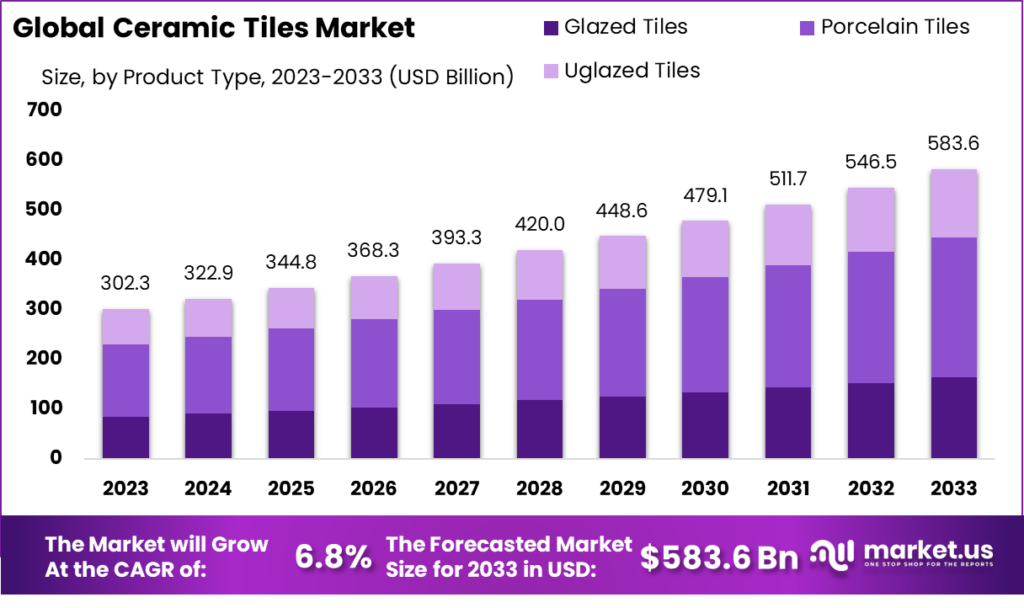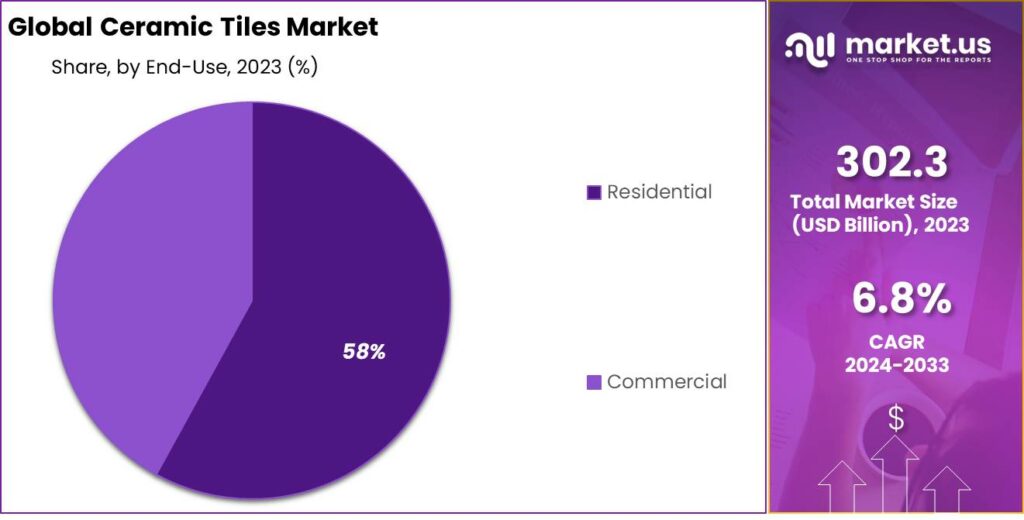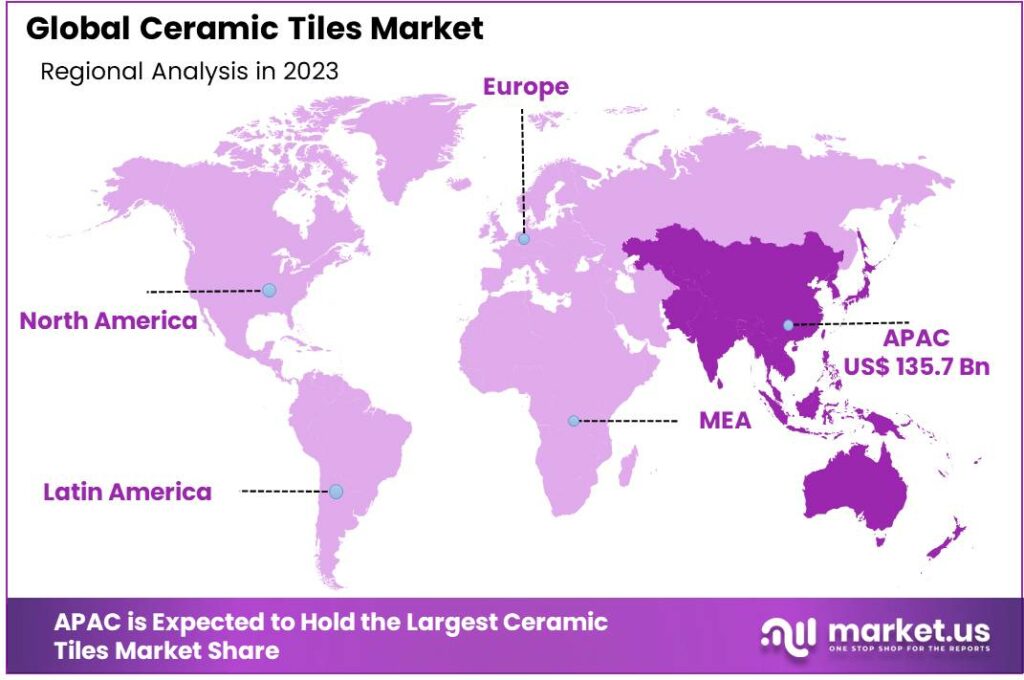New York, Feb. 06, 2024 (GLOBE NEWSWIRE) -- According to Market.us, Ceramic Tile Market was valued at USD 302.3 Billion in 2023, and it is expected to reach USD 583.6 Billion by 2033. Between 2023 and 2033, this market is estimated to register a CAGR of 6.8%.
The Ceramic Tile Market refers to the industry involved in the production, distribution, and sale of ceramic tiles. Ceramic tiles are versatile, durable, and aesthetically pleasing building materials made from clay, sand, and other natural substances. These tiles find extensive use in flooring, wall coverings, and various architectural applications due to their durability, ease of maintenance, and wide range of design options.
The market encompasses manufacturers, suppliers, distributors, and retailers contributing to the production and consumption of ceramic tiles for residential, commercial, and industrial construction projects. The Ceramic Tile Market is influenced by factors such as construction trends, design preferences, technological advancements, and economic conditions.
To Gain greater insights, Request a sample report @ https://market.us/report/ceramic-tile-market/request-sample/

Important Revelation:
- Market Size Projection: The Ceramic Tile Market is anticipated to reach USD 583.6 billion by 2033, growing steadily at a CAGR of 6.8%, starting from its 2023 valuation of USD 302.3 billion.
- Porcelain Tiles Dominance: In 2023, Porcelain Tiles held the lead in product types, commanding a substantial 48.3% market share, driven by attributes like durability and design versatility.
- Flooring Segment Supremacy: The Flooring segment dominated with a market share exceeding 52.0% in 2023, showcasing ceramic tiles' preference for flooring applications due to durability and aesthetic choices.
- Residential Sector Leadership: The Residential segment secured over 58% of the market in 2023, propelled by ceramic tiles' use in residential construction for walls, backsplashes, and countertops.
- Regional Dominance - Asia-Pacific: Asia-Pacific claimed a dominant position in 2023, holding a market share exceeding 44.9%, fueled by rapid urbanization and infrastructure development, particularly in China and India.
Factors Affecting the Growth of the Global Ceramic Tile Market
- Construction Industry Trends: The ceramic tile market is closely tied to the construction sector. Growth in residential, commercial, and infrastructure construction projects globally positively impacts the demand for ceramic tiles.
- Economic Conditions: Economic stability and growth influence consumer spending on home improvement and construction projects, directly impacting the demand for ceramic tiles.
- Urbanization and Population Growth: Increasing urbanization and a growing global population drive the demand for housing and infrastructure, stimulating the consumption of ceramic tiles in construction.
- Technological Advancements: Innovations in tile manufacturing technologies enhance product quality, design capabilities, and cost-effectiveness, contributing to market growth.
- Design Trends and Aesthetics: Evolving design preferences and trends in architecture and interior design influence the demand for aesthetically pleasing and customizable ceramic tiles.
Market Drivers
The ceramic tile market is experiencing a boost from the global construction surge, particularly in emerging economies. The rise in urbanization and infrastructure projects, coupled with the demand for attractive interiors, propels the use of ceramic tiles in both residential and commercial constructions.
Ceramic tiles are favored for their durability and low maintenance, making them ideal for high-traffic areas. Resistant to stains and easy to clean, these tiles are a practical choice for flooring in various spaces, contributing to their widespread adoption.
Continuous innovation in manufacturing, especially with digital printing technology, expands design possibilities for ceramic tiles. This innovation meets the increasing demand for personalized and visually appealing options, attracting consumers seeking unique solutions.
The ceramic tile industry responds to growing environmental concerns by promoting sustainability. Made from natural materials, ceramic tiles are considered eco-friendly. Manufacturers invest in energy-efficient production methods, further enhancing the tiles' environmental friendliness and aligning with the global shift towards eco-conscious construction materials.
Restraining Factors
The ceramic tile market is fiercely competitive, with numerous manufacturers vying for market share. This intense competition creates pricing pressures, impacting profit margins for industry players. Additionally, the industry grapples with fluctuating raw material prices, particularly for clay and minerals, posing challenges in managing production costs when prices unexpectedly rise.
Despite the long-term benefits of ceramic tiles, their installation can be labor-intensive and complex, requiring skilled professionals. This complexity, coupled with associated costs, may deter some consumers from choosing ceramic tiles over more straightforward flooring options.
Global economic uncertainties contribute to market challenges. Economic fluctuations and uncertainties can directly impact the construction industry and, consequently, the demand for ceramic tiles. Economic downturns or slowdowns in construction activities can hinder the overall growth of the ceramic tile market.
Growth Opportunities
The ceramic tile industry finds growth potential in the ongoing urbanization of emerging markets, as the demand for commercial and residential spaces is expected to rise with increasing urban populations. Manufacturers can seize opportunities by introducing innovative products such as large-format tiles and those with textured surfaces or modern features like antimicrobial properties.
Export markets offer an avenue for expansion, allowing ceramic tile manufacturers to reach new customers. Targeting regions with growing construction sectors or high renovation rates can diversify revenue streams. Embracing digital marketing strategies and utilizing e-commerce platforms enables direct engagement with a wider audience, providing a means for ceramic tile companies to connect with consumers and streamline sales processes, bypassing traditional distribution channels.
Drive Your Growth Strategy! Purchase the Report to Uncover Key Insights: https://market.us/purchase-report/?report_id=17524
Competitive Landscape
The competitive landscape of the market has also been examined in this report. Some of the major players include:
- Mohawk Industries, Inc.
- ATLAS CONCORDE S.P.A.
- Crossville Inc.
- Cerámica Saloni, Florida Tile, Inc.
- Guangdong Newpearl Ceramics Group Co.
- RAK Ceramics
- Kajaria Ceramics Ltd.
- China Ceramics Co., Ltd.
- Porcelanosa Group
- Ricchetti Group
- Other Key Players
Report Segmentation
Product Type Analysis
In 2023, the Ceramic Tile market witnessed notable trends in product segments, with Porcelain Tiles emerging as the leader, securing a dominant share of over 48.3%. This dominance is attributed to the growing preference for porcelain tiles, driven by their durability, low maintenance, and versatile design applications. The increased adoption of porcelain tiles in residential and commercial projects has further strengthened their market presence. Manufacturers are strategically emphasizing the production and promotion of porcelain tiles to capitalize on this lucrative market segment.
Application Analysis
In 2023, the Ceramic Tile market showcased significant developments in application segments, including Wall, Floor, Roof, and Others. The Floor segment emerged as the dominant force, claiming over 52.0% market share. This dominance is driven by the widespread use of ceramic tiles in flooring applications in both residential and commercial spaces.
Ceramic floor tiles' popularity is attributed to their durability, ease of maintenance, and diverse design options, making them preferred by consumers and project developers. The growing emphasis on aesthetics and interior design in modern construction projects has further fueled the demand for ceramic tiles in flooring. Manufacturers strategically align product offerings and marketing efforts to meet the flourishing demand, solidifying their leadership in the market.
End-Use Analysis
In 2023, the Ceramic Tile market showcased the Residential segment as the dominant force, securing over 58% market share. This emphasizes the residential sector's pivotal role in driving ceramic tile consumption. The growth in residential construction, renovations, and increased homeowner disposable income contributed to the strong demand for ceramic tiles.
The trend of using ceramic tiles for various applications, including walls, backsplashes, and countertops, further fueled the segment's growth. The Residential segment's dominance highlights the enduring popularity of ceramic tiles among homeowners and the industry's commitment to meeting evolving preferences.

Kеу Маrkеt Ѕеgmеntѕ
By Product Type
- Glazed Tiles
- Porcelain Tiles
- Uglazed Tiles
By Application
- Wall
- Floor
- Roof
- Others
By End-Use
- Residential
- Commercial
Access a comprehensive market analysis featuring key trends, drivers, and challenges, empowering clients to optimize their strategies and outshine competitors. Check out the PDF sample report @ https://market.us/report/ceramic-tile-market/request-sample/
Scope of the Report
| Report Attributes | Details |
| Market Value (2023) | USD 302.3 Billion |
| Forecast Revenue 2033 | USD 583.6 Billion |
| CAGR (2024 to 2033) | 6.8% |
| Asia-Pacific Revenue Share | 44.9% |
| Base Year | 2023 |
| Historic Period | 2018 to 2022 |
| Forecast Year | 2023 to 2032 |
Regional Analysis
In 2023, the Ceramic Tile market witnessed distinctive regional trends. Asia-Pacific (APAC) took the lead with over 44.9% market share, valued at USD 135.7 billion. APAC's dominance results from rapid urbanization, robust construction, and a growing middle class favoring modern housing solutions, notably seen in China and India. Skilled labor and cost-effective manufacturing further fueled the region's ceramic tile industry growth.
In contrast, North America and Europe represented more mature markets. North America's steady presence was driven by residential renovations, while Europe experienced slower growth due to economic factors. Latin America showed growth potential, driven by investments in commercial spaces, and the Middle East and Africa exhibited promise with expanding construction and hospitality projects.
Understanding these regional dynamics is crucial for industry stakeholders to tailor effective strategies, considering unique market conditions and consumer preferences, maximizing opportunities in the global Ceramic Tile market.

By Geography
- North America
- The US
- Canada
- Europe
- Germany
- France
- The UK
- Spain
- Italy
- Russia
- Netherland
- Rest of Europe
- APAC
- China
- Japan
- South Korea
- India
- Australia
- New Zealand
- Singapore
- Thailand
- Vietnam
- Rest of APAC
- Latin America
- Brazil
- Mexico
- Rest of Latin America
- Middle East & Africa
- South Africa
- Saudi Arabia
- UAE
- Rest of MEA
Explore Extensive Ongoing Coverage on Chemicals and Materials Reports Domain:
- Hydrazine Hydrate market size accounted for USD 551 Million and is expected to grow to around USD 878 Million in 2032. Between 2023 and 2032, this market is estimated to register the highest CAGR of 4.9%.
- Thermoplastic Vulcanizates Market size is expected to be worth around USD 4 Billion by 2032 from USD 2.1 Billion in 2022, growing at a CAGR of 6.80% during the forecast period from 2023 to 2032.
- battery recycling market was valued at USD 11 billion and it is expected to reach USD 23.7 billion by 2032. Between 2023 and 2032, this market is estimated to register the highest CAGR of 8.2%.
- azelaic acid market size is expected to be worth around USD 422.21 million by 2032 from USD 218.29 million in 2022, growing at a CAGR of 7.0% during the forecast period from 2022 to 2032.
- waste management market size accounted for USD 980.7 billion and will reach USD 1607.6 billion by 2032. Between 2023 and 2032, this market is estimated to register a CAGR of 5.2%
- Stainless Steel Market size is expected to be worth around USD 264 billion by 2032 from USD 131.5 billion in 2022, growing at a CAGR of 7.4% during the forecast period 2023 to 2032.
- Acetic Acid Market size is expected to be worth around USD 35.2 billion by 2032 from USD 21.8 billion in 2022, growing at a CAGR of 4.90% during the forecast period from 2022 to 2032.
- Specialty Chemicals Market size was valued at USD 650 billion in 2022 and is expected to reach USD 1036 billion growing at a CAGR of 4.9% during the forecast period of 2023-2032.
- isostearic acid market was valued at USD 404.7 million and is expected to reach USD 768.6 million in 2032. This market is estimated to register a CAGR of 6.8% between 2023 and 2032
- polyphenylene sulfide market size accounted for USD 1451 million and is expected to reach USD 3362 million in 2032. This market is estimated to register a CAGR of 9.0% between 2023 and 2032.
About Us:
Market.US (Powered by Prudour Pvt Ltd) specializes in in-depth market research and analysis and has been proving its mettle as a consulting and customized market research company, apart from being a much sought-after syndicated market research report-providing firm. Market.US provides customization to suit any specific or unique requirement and tailor-makes reports as per request. We go beyond boundaries to take analytics, analysis, study, and outlook to newer heights and broader horizons.
Follow Us on LinkedIn
Our Blog:
